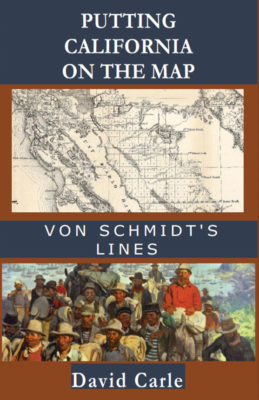By David Carle | Phalarope Press
ISBN-13: 978-1987736434
ISBN-10: 1987736435
208 pp
 Land Surveying has a very rich history in these United States of America. Most surveyors point with pride to the men who have come to define and create this country by drawing lines on maps and land. Amongst the most significant of these men, several have had an extraordinary influence on the lands they charted and they include Washington, Lincoln, Banneker, Jefferson, Lewis, and Clark, all of whom come to mind naturally.
Land Surveying has a very rich history in these United States of America. Most surveyors point with pride to the men who have come to define and create this country by drawing lines on maps and land. Amongst the most significant of these men, several have had an extraordinary influence on the lands they charted and they include Washington, Lincoln, Banneker, Jefferson, Lewis, and Clark, all of whom come to mind naturally.
In the eastern states where Washington, Lincoln, and others operated, they worked within a system adopted from England, where much of our laws come from. It wasn’t until Thomas Jefferson developed the rectangular system before the vast hills, valleys and mountain of America were corralled. Once Jefferson’s system was in place, men like Lewis and Clark, and John Fremont, opened the great curtain and gave the country a peek at what lay west. Unlike the eastern parts of the country, rich with water, streams, lakes, and rivers and plush, fertile valleys, the lands west, were anything but bucolic. They were harsh and hostile, barren and tough country filled with angry native Americans, buffalo as far as the eye could see and snakes as thick as a man’s leg.
Other than the various manuals, adopted from Jefferson’s guidelines, early surveyors had to rely on their wit and wile to create a country and this required men of exceptional intelligence, bravery, and instincts. At the risk of hyperbole, this was not a job for mere mortals. It was a job for extraordinary men; men like Allexey W. von Schmidt, a surveyor and engineer who claimed California as his home from the great gold rush days of 1849 to 1906, the year of the great San Francisco, a disaster that destroyed the city and much of Von Schmidt’s work.
Author David Carle, a former California State Park Ranger, has published a very comprehensive book, sure to please historian buffs, land surveyors, and anyone interested in the history of California. Carle’s research is impressive and informative and best of all, a pleasure to read, unlike stoic stories that lull the reader to sleep. As Carle points out, with great gusto, Von Schmidt’s impact and influence on California are quite remarkable given the magnitude of his efforts along with the size of the state.
In addition to his prowess in surveying, Von Schmidt was an engineer who designed and built some of the state’s most impressive utility systems including San Francisco’s first long-distance water delivery system. He also developed a system of underwater excavation of a spectacular dry dock for repairing ships. He is akin to today’s Elon Musk, an innovator in many areas of science and engineering. Perhaps his greatest accomplishment is establishing the boundary line between California and Arizona, in 1872 and 1873.
On its face, the legislatively-devised line was a simple matter on paper, established at the state’s 1850 constitutional convention, setting the line on the 120th meridian, south from the Oregon border, to an intersection with 39 degrees in latitude, placing the corner at the bottom of Lake Tahoe, hardly a station that could ever be occupied. From there, the line continued south to an intersection with 35 degrees north latitude and the sinewy, and ever-moving Colorado River, another angle point that moved on a daily basis.
Carle brings to life the incredible challenges Von Schmidt and his crews encountered including bears, hostile Indians, and adverse weather. He also credits, rightfully so, Von Schmidt’s import in the development of California:
The survey lines Allexey W. von Schmidt laid down across much of the state guided the development of homesteads, ranches, and towns. He had the curiosity and energy to go first into unknown places, to lead to others could follow. . . Allexey Waldemar von Schmidt’s life’s work helped put California on the map.”
For anyone interested in learning how a country is built, I recommend David’s book. It is a rare treat for all.